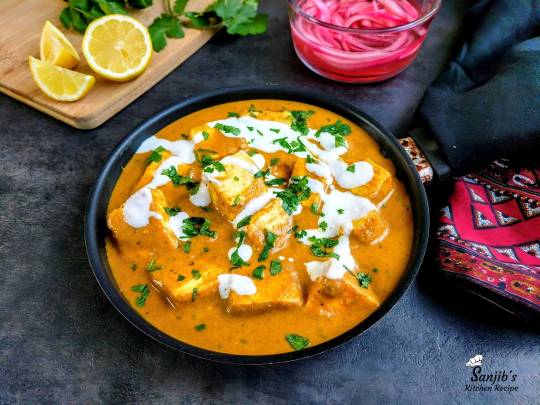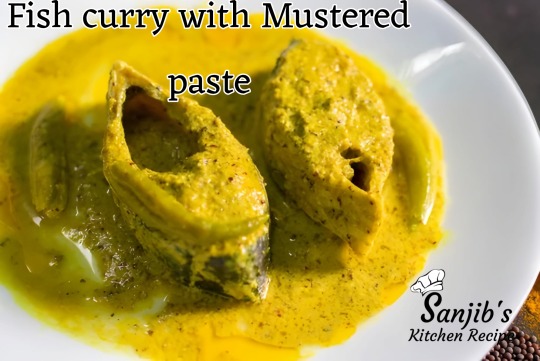Text
Bengali style Fish curry

https://sanjibskitchenrecipe.com/delicious-bengali-fish-curry/
Bengali fish curry, also known as “Maacher Jhol,” is a classic and beloved dish in Bengali cuisine. It’s a flavorful and aromatic curry that showcases the region’s love for fish and intricate blend of spices. This delectable curry is perfect for any occasion, whether you’re hosting a family gathering or simply craving a comforting and satisfying meal.
Bengali fish curry Ingredients:
5-6 pieces of fresh fish (such as Rahu or Katla)
2 medium-sized onions, julienned
100 gm tomato paste
10 ml mustard oil
1/2 tablespoon turmeric powder
1 tablespoon red chili powder
1 tablespoon coriander powder
Salt to taste
1/2 teaspoon garam masala
Bengali fish curry Preparation:
Begin by cleaning the fish pieces thoroughly under running water. Pat them dry with a paper towel or clean kitchen cloth.
In a mixing bowl, combine the fish pieces with a pinch of salt and turmeric powder. Gently massage the marinade into the fish, ensuring each piece is evenly coated. Set aside for 10-15 minutes to allow the flavors to meld.
Heat mustard oil in a pan or kadhai over medium-high heat. Once the oil is hot, carefully add the marinated fish pieces and fry until they turn crispy and golden brown on both sides. Remove the fried fish from the pan and set it aside on a plate lined with a paper towel to absorb any excess oil.
In the same pan, heat a little more mustard oil. Once the oil is hot, add the julienned onions and sauté until they turn golden brown and fragrant.
Next, add the dry spices: turmeric powder, red chili powder, coriander powder, and salt. Stir continuously for about 1-2 minutes, allowing the spices to bloom and release their aroma.
Incorporate the tomato paste into the pan and cook for 2-3 minutes, stirring frequently, until the paste is well combined with the spices and onions.
Carefully add the fried fish pieces to the pan and gently mix them with the spiced tomato mixture, ensuring each piece is coated evenly.
Pour in about 1 cup (100 ml) of water and sprinkle the garam masala over the curry. Give it a gentle stir to combine everything well.
Cover the pan with a lid and let the curry simmer on low heat for about 5-7 minutes. This step allows the flavors to meld together and the fish to absorb the rich, aromatic curry sauce.
After simmering, remove the lid and check the consistency of the curry. If you prefer a thinner gravy, add a little more water and let it cook for an additional 2-3 minutes.
Once the desired consistency is achieved, turn off the heat and let the curry rest for a few minutes before serving.
To serve, ladle the Bengali fish curry into bowls or plates and garnish with fresh coriander leaves or a sprinkle of garam masala. This delectable curry pairs beautifully with steamed rice, allowing the aromatic gravy to soak into each fluffy grain.
Bengali fish curry is a true celebration of flavors, showcasing the perfect harmony between the fresh fish, aromatic spices, and tangy tomato base. The depth of flavor in this dish is truly remarkable, with each bite offering a burst of taste and aroma that will transport you to the heart of Bengali culinary traditions.
Whether you’re a seasoned Bengali food enthusiast or simply seeking to explore new flavors, this authentic fish curry is sure to delight your senses and leave you craving for more. Enjoy it with loved ones, savor each bite, and let the warmth and comfort of this dish envelop you in a culinary embrace that captures the essence of Bengali hospitality and deliciousness.
Here are some potential FAQs for the Bengali Fish Curry recipe:
Q: What types of fish are best suited for this curry?
A: This curry is traditionally made with freshwater fish like Rahu (Rohu) or Katla. However, you can also use other varieties of fresh fish such as Bhetki (Barramundi), Parshe (Indian Salmon), or even Hilsa if available.
Q: Can I use a different type of oil instead of mustard oil?
A: Mustard oil is preferred for its distinct flavor and aroma, but you can substitute it with vegetable oil, canola oil, or sunflower oil if you don’t have mustard oil.
Q: Can I adjust the spice level of the curry?
A: Yes, you can easily adjust the spice level to suit your taste. Reduce the amount of red chili powder to make it milder or increase it for a spicier curry.
Q: Can I use fresh tomatoes instead of tomato paste?
A: Yes, you can use fresh tomatoes. Roughly chop 2-3 medium-sized tomatoes and cook them down until they form a pulp before adding the spices.
Q: Can I add any vegetables to the curry?
A: While this curry is traditionally made without vegetables, you can add potatoes, cauliflower, or eggplant to make it more substantial and create a heartier meal.
Q: How do I achieve a thicker gravy consistency?
A: If you prefer a thicker gravy consistency, you can mash a few pieces of the cooked fish into the curry or add a cornstarch slurry (mix cornstarch with water) towards the end of cooking.
Q: Can I make this curry ahead of time?
A: Yes, this curry can be made ahead of time and stored in the refrigerator for up to 3-4 days. The flavors will develop further, and you can gently reheat the curry before serving.
Q: Can I freeze the leftovers?
A: Yes, you can freeze the leftover fish curry for up to 2-3 months. However, keep in mind that the texture of the fish may change slightly after freezing and thawing.
Q: What should I serve with the Bengali fish curry?
A: This curry is traditionally served with steamed rice, but you can also pair it with Indian flatbreads like paratha, naan, or luchi (Bengali-style puffy bread).
#fishcurry#fishcurryrecipe#bengalicuisine#bengalifishcurry#lunchbox#lunchideas#dinner ideas#foodies#foodlover#foodblogger#foodporn#foodgasm#foodphotography
0 notes
Text
Marwadi Paneer Masala
Rajasthani style Marvadi Paneer Masala
Marvadi Rajasthani Paneer Masala is a delectable dish that combines the rich flavors of Rajasthani spices with the creaminess of paneer (Indian cottage cheese). This dish is a true delicacy, originating from the arid regions of Rajasthan, where the cuisine is known for its robust and aromatic flavors. The unique blend of spices, along with the use of papad (crispy lentil wafers) powder, adds a distinct texture and depth to the gravy, making it a culinary gem.
Marvadi Rajasthani Paneer Masala Ingredients:
Paneer: 250 gm
Onion: 1 medium-sized
Tomato: 1 medium-sized
Ginger-garlic paste: 1 teaspoon
Oil: 3 tablespoons
Papad: 2-3 pieces
Turmeric powder: 1/2 teaspoon
Chili powder: 1 teaspoon
Coriander powder: 1 tablespoon
Garam masala: 1/2 teaspoon
Salt to taste

https://sanjibskitchenrecipe.com/
0 notes
Text
Mustard fish curry

Mustered Fish curry
Home style mustard fish curry
@followers Highlight
Mustard Fish Curry is a tantalizing dish that has its roots in the Bengali cuisine. It’s a delightful amalgamation of fresh fish, aromatic spices, and the distinctive flavor of mustard, creating a symphony of flavors that will leave you craving for more. This curry is not only a culinary delight but also a testament to the rich culinary heritage of Bengal.
0 notes
Text
https://sanjibskitchenrecipe.com/delicious-traditional-malabar-fish-curry/

Home Made Malabar fish curry
malabarfishcurry #fishcurry #southindianfish #keralafishcurry #foodstylist #foodblogger #foodlover #southindianfood #southindianfoodie #southindianfoodlove #foodlover #foodrecipes #foodphotography #recipebooks @followers Highlight
This classic Malabar fish curry recipe is a delightful blend of aromatic spices, coconut, and tamarind, creating a flavorful and tangy gravy that perfectly complements the tender fish. Originating from the coastal regions of Kerala, this dish is a beloved staple in households across the state and is renowned for its unique and mouth-watering taste.
Malabar fish curry Ingredients:
Fresh Sea Fish (any variety): 1 kg
Chopped Onion: 100 gm
Chopped Ginger: 1 tablespoon
Chopped Garlic: 1/2 tablespoon
Mustard Seeds: 1/2 tablespoon
Kadi Leaves (Curry Leaves): 5-10 pieces
Oil: 20 ml
Chopped Tomato: 1 medium-sized tomato
Raw Coconut: 50 gm
Turmeric Powder: 1/2 tablespoon
Chili Powder: 1 tablespoon
Coriander Powder: 1.5 tablespoons
Kashmiri Dry Red Chilies: 2-3
Kodam Pulli (Malabar Tamarind): 10 gm
Salt to taste
0 notes
Text
0 notes
Text
0 notes
Text
0 notes
Text
0 notes
Text
1 note
·
View note